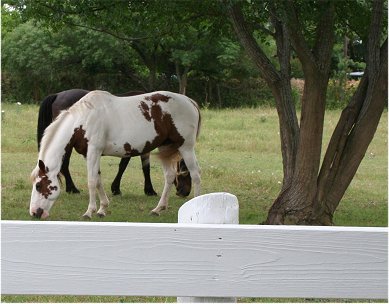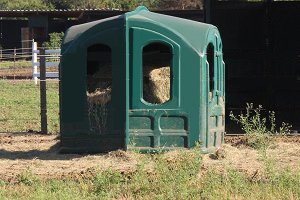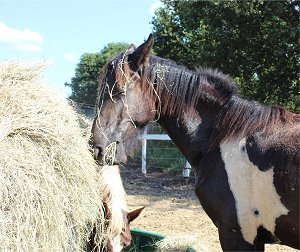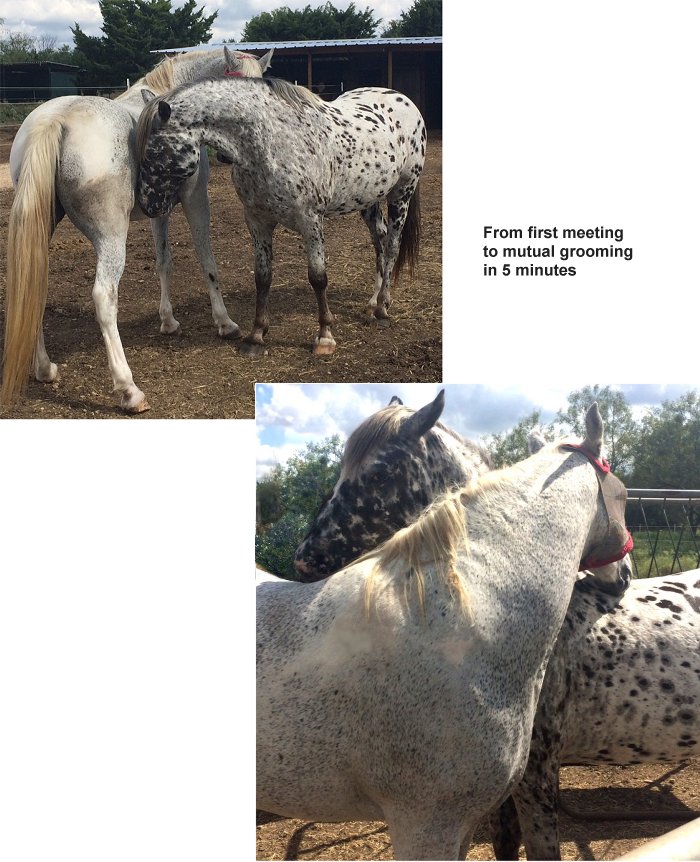Let’s start at the end of our quest instead of the beginning: A round bale with a hay net requires less time to feed daily, uses less hay per horse, keeps horses happier because it provides more natural forage, and will reduce your own stress level as horses calm down and stop worrying themselves and their environment.
Over the past 30 years, we have kept more than 50 horses of different breeds and sexes at any one time on limited acreage. We have no land to grow our own food, so working as efficiently as possible is the only way to survive. We have tried nearly every method of feeding, pasturing and caring for them for optimal health. Here’s an important part of what we have learned.
 Horses in nature forage continually. In fact their digestive tract is made to push small amounts of food into the intestines and out the other end on a continual basis – up to 12 manure dumps per day per horse.
Horses in nature forage continually. In fact their digestive tract is made to push small amounts of food into the intestines and out the other end on a continual basis – up to 12 manure dumps per day per horse.
Not only does their entire digestive system work best with continual forage, but their minds are also more content when their mouth is moving – as in eating.
It is a fairly new phenomenon that horses are kept in confined areas and fed twice a day. While they can get adequate calories from this routine, we have noticed over the years that horses who are not occupied with eating are more likely to develop bad habits out of boredom: cribbing, fence pushing, fence fighting, and nervous pacing can all be helped by feeding a forage-schedule diet.
Round bales are frequently the answer. Having constant access to a round bale will keep a horse content and well fed. One large round bale at the Kristull Ranch usually lasts one horse about a month.
 Because we have two very rainy seasons per year that will ruin the hay if it gets too wet, we recommend a “Hay Hut” cover. It prevents spoilage, prevents waste outside the hut, and keeps horses sharing without encroaching on each other. If you cannot currently afford a hay hut, keep at least 4 horses in a community paddock where they will eat an uncovered bale in a week. (A week is usually not long enough for it to spoil except in the most soaking rain conditions.)
Because we have two very rainy seasons per year that will ruin the hay if it gets too wet, we recommend a “Hay Hut” cover. It prevents spoilage, prevents waste outside the hut, and keeps horses sharing without encroaching on each other. If you cannot currently afford a hay hut, keep at least 4 horses in a community paddock where they will eat an uncovered bale in a week. (A week is usually not long enough for it to spoil except in the most soaking rain conditions.)
 Our Observations:
Our Observations:
Any time one of our community paddocks runs out of hay in the hay ring, the horses immediately begin to worry the fences – reaching for the green pastures on the other side of the fence. This leads to fence damage and sometimes to mane damage where they reach through the wooden fences and rub their mane hair off, leaving an ugly patch of broom in the middle of their neck.
Round bale feeding usually goes hand in hand with community living. And community living goes hand-in-hand with horse’s social needs. See: The Case Against Stalling and Pasture Etiquette

Need some more food for thought?
1. Round bales save money. They usually cost less than half of what square bales cost per horse.
2. Round bales save time and manpower. Although it is true that you may need a tractor if you manage a lot of horses, round bales require less manpower than hand-feeding individual horses, so labor costs are reduced.
3. Round bales keep horses both happier and healthier. Less cholic, less neurotic behavior, less environmental stress that causes repair and maintenance issues.
4. A hay net or hay hut will reduce the spoilage and raise the bottom line of your business. A hay net will reduce the ridiculous spoilage associated with hay all around the feeder that is lost. Our experience is that it reduces spoilage by more than 75%.
5. A hay net will save time by reducing the time spent cleaning up spoiled hay around a feeder.
Summary: A round bale with a hay net requires less time to feed daily, uses less hay per horse, keeps horses happier because it provides more natural forage, and will reduce your own stress level as horses calm down and stop worrying themselves and their environment.
Caution: We have found that horses who wear shoes in their paddocks, might get their shoes caught in the net if they are able to actually walk into and onto it.
